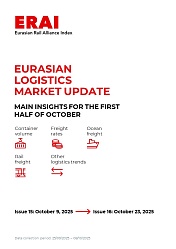According to the Eurasian Rail Alliance, traffic volumes increased by more than 80% compared to 2023, reaching 380,434 TEU. Despite the development of the Trans-Caspian Corridor, most cargo continues to move along the northern route via Poland, which accounted for 55.7% of the total last year.
Alternative routes have become popular amid the crisis in the Red Sea, which forced shipping companies to reroute vessels around the Cape of Good Hope, leading to longer delivery times and a sharp rise in sea freight costs. The average freight cost from Shanghai to Rotterdam increased by 78%, while rail rates remained stable. According to the Eurasian Rail Alliance Index, in 2024, freight transport by rail from China to Europe was on average 59% cheaper than by sea.
The most significant growth in freight traffic was recorded in the China-Germany direction: the volume of shipments reached 23,790 TEU, which is 84.9% more than a year earlier. At the same time, exports from Germany to China decreased by 33% — to 39,079 TEU. A similar situation is observed in Poland, where export rail transportation from Europe to China remains several times lower than import, although in 2024 the volume of containers shipped from Poland increased by 24%.




